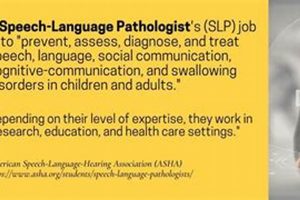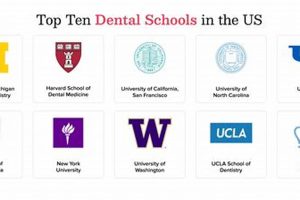Top-tier educational programs for magnetic resonance imaging technologists typically offer a blend of classroom instruction and clinical experience, covering topics such as anatomy, physiology, patient care, and the physics behind MRI technology. Graduates of these programs are equipped to operate MRI scanners, position patients, and acquire high-quality images used for medical diagnoses.
High-quality educational institutions in this field play a vital role in healthcare by producing skilled professionals who contribute to accurate and timely diagnoses. The demand for qualified MRI technologists is steadily increasing due to advancements in medical imaging and the growing need for non-invasive diagnostic procedures. This career path offers promising opportunities for individuals interested in a technically challenging and rewarding profession in a dynamic healthcare environment.
The following sections will explore various factors to consider when selecting an MRI technology program, including accreditation, curriculum, clinical opportunities, and career prospects.
Tips for Selecting a Top MRI Technology Program
Choosing the right educational path is crucial for a successful career in magnetic resonance imaging. Careful consideration of several key factors can help prospective students identify programs that align with their career goals and provide a strong foundation for professional growth.
Tip 1: Accreditation Matters: Seek programs accredited by recognized bodies like the Joint Review Committee on Education in Radiologic Technology (JRCERT). Accreditation ensures the program meets established quality standards and may be required for certification and licensure.
Tip 2: Comprehensive Curriculum: A robust curriculum should cover a range of topics, including cross-sectional anatomy, MRI physics, patient positioning, safety protocols, and image acquisition techniques.
Tip 3: Clinical Experience is Key: Extensive clinical rotations in diverse healthcare settings provide practical experience and exposure to various MRI procedures and patient populations. Look for programs with strong partnerships with local hospitals and clinics.
Tip 4: Faculty Expertise: Experienced and qualified faculty members can provide valuable mentorship and guidance. Research the faculty’s credentials and professional backgrounds.
Tip 5: Advanced Technology: Ensure the program utilizes modern MRI equipment and software to prepare students for the current technological landscape in the field.
Tip 6: Career Services Support: Robust career services can assist with job placement, resume writing, interview preparation, and professional networking opportunities.
Tip 7: Consider Program Location and Format: Evaluate the program’s location and format (online, hybrid, or on-campus) to ensure it aligns with individual circumstances and preferences.
By carefully considering these factors, aspiring MRI technologists can make informed decisions and select programs that provide the necessary knowledge, skills, and experience to excel in this demanding and rewarding field.
The insights provided here aim to equip prospective students with the tools to navigate the process of choosing the optimal MRI technology program and embark on a successful career path.
1. Accreditation
Accreditation serves as a critical marker of quality in MRI technology education. It signifies that a program meets established standards set by recognized accrediting bodies, ensuring a comprehensive and rigorous curriculum. For prospective students, accreditation is a key factor to consider when evaluating potential programs and plays a vital role in career prospects.
- Ensuring Program Quality
Accrediting agencies, such as the Joint Review Committee on Education in Radiologic Technology (JRCERT), evaluate programs based on established criteria, including curriculum content, faculty qualifications, clinical resources, and student outcomes. This rigorous evaluation process ensures programs maintain high standards and provide students with the necessary knowledge and skills.
- Meeting Professional Standards
Graduating from an accredited program is often a prerequisite for professional certification and state licensure. The American Registry of Radiologic Technologists (ARRT), a leading certification organization, requires completion of an accredited program for eligibility to sit for the MRI certification exam. This connection between accreditation and certification underscores its importance in career advancement.
- Enhancing Employability
Employers often prefer candidates who have graduated from accredited programs, recognizing the value of a standardized education. Accreditation signals to employers that a candidate has received a comprehensive education that meets industry standards, making graduates more competitive in the job market.
- Promoting Continuous Improvement
The accreditation process encourages continuous improvement within MRI technology programs. Programs must regularly undergo review to maintain accreditation, prompting ongoing evaluation and refinement of curriculum, resources, and practices. This commitment to quality enhancement benefits students by ensuring they receive a current and relevant education.
By prioritizing accredited programs, prospective MRI technologists invest in their future careers. Accreditation not only ensures a high-quality education but also strengthens professional credentials and enhances employment prospects. This critical factor distinguishes the best MRI tech schools, setting a benchmark for excellence in the field.
2. Clinical Placements
Clinical placements form a cornerstone of top-tier MRI technology programs, bridging theoretical knowledge with practical application. These placements offer students invaluable hands-on experience in real-world healthcare settings, directly impacting their preparedness for professional practice. The quality and breadth of clinical experiences contribute significantly to distinguishing the best MRI tech schools.
Effective clinical placements provide opportunities to apply classroom learning in dynamic clinical environments. Students gain proficiency in patient interaction, MRI safety protocols, scanner operation, and image acquisition techniques. Exposure to diverse patient populations and pathologies broadens their understanding of the practical application of MRI technology. For instance, a student placed in a trauma center gains experience with emergency MRI procedures, while a placement in an outpatient imaging center provides exposure to routine diagnostic scans. Such varied experiences cultivate adaptability and comprehensive skill development.
Strong partnerships between educational institutions and healthcare facilities are essential for robust clinical placements. These collaborations ensure access to state-of-the-art equipment, diverse patient caseloads, and mentorship from experienced professionals. The quantity, quality, and variety of clinical sites directly influence the depth and breadth of student learning. Furthermore, clinical placements offer networking opportunities, fostering professional connections that can prove invaluable for future career prospects. Successful completion of diverse clinical rotations demonstrates competency and professionalism, making graduates highly sought after by employers. The emphasis on practical experience solidifies the connection between clinical placements and the hallmarks of best MRI tech schools.
3. Faculty Expertise
Faculty expertise stands as a cornerstone of high-quality MRI technology programs. Experienced and knowledgeable instructors contribute significantly to the educational experience, directly influencing student learning outcomes and career preparedness. The caliber of faculty expertise often distinguishes best MRI tech schools from average programs.
Accomplished faculty members bring a wealth of practical experience and theoretical knowledge to the classroom. Instructors with substantial clinical backgrounds offer real-world insights into the complexities of MRI procedures, patient care, and diagnostic interpretation. Their expertise translates into engaging and relevant instruction, enriching the learning environment and fostering a deeper understanding of the field. For instance, a faculty member with specialized expertise in cardiac MRI can provide students with in-depth knowledge and practical skills in this specific area. Moreover, faculty actively engaged in research contribute to the advancement of the field, exposing students to cutting-edge technologies and innovative techniques. This exposure prepares graduates for a rapidly evolving technological landscape and encourages lifelong learning.
The impact of faculty expertise extends beyond technical proficiency. Dedicated instructors serve as mentors and role models, guiding students through the challenges of academic and professional development. They provide personalized feedback, foster critical thinking skills, and instill professional values crucial for success in the healthcare field. Strong mentorship can significantly influence career trajectories, helping students develop the confidence and competence necessary to excel as MRI technologists. Ultimately, the presence of highly qualified and dedicated faculty is a defining characteristic of best MRI tech schools, underscoring the essential role of expert instruction in producing competent and compassionate healthcare professionals.
4. Cutting-Edge Technology
Access to cutting-edge technology is a defining characteristic of best MRI tech schools. The rapid advancements in medical imaging necessitate that educational programs provide students with experience using the latest equipment and software. This exposure is crucial for preparing graduates to enter the workforce proficient in current industry standards and equipped to adapt to future technological developments. The integration of advanced technology into the curriculum directly impacts the quality of education and enhances career prospects.
- Advanced MRI Systems
Best MRI tech schools invest in state-of-the-art MRI systems, including high-field strength magnets, advanced coil technology, and sophisticated software platforms. These systems offer enhanced image quality, faster scan times, and advanced imaging techniques, such as functional MRI (fMRI) and diffusion tensor imaging (DTI). Experience with these technologies provides students with a competitive edge in the job market and prepares them to contribute effectively in clinical settings utilizing the latest advancements. For example, hands-on training with 3T MRI scanners exposes students to the technology increasingly prevalent in modern hospitals.
- Image Processing and Analysis Software
Proficiency in advanced image processing and analysis software is essential for MRI technologists. Best MRI tech schools incorporate training on industry-leading software packages, enabling students to manipulate and analyze images, generate 3D reconstructions, and perform quantitative measurements. This skill set is crucial for accurate diagnosis and treatment planning and enhances the value of MRI technologists within healthcare teams. Familiarity with software platforms like OsiriX or Mimics provides practical skills applicable in various clinical and research settings.
- Artificial Intelligence (AI) in MRI
The integration of artificial intelligence (AI) is transforming the field of medical imaging. Best MRI tech schools expose students to AI-powered tools for image acquisition, processing, and interpretation. These tools can enhance workflow efficiency, improve image quality, and assist in diagnostic decision-making. Familiarity with AI applications in MRI prepares graduates for the future of the field and equips them to leverage these technologies for improved patient care. For example, exposure to AI-driven noise reduction algorithms demonstrates the potential of AI to enhance image quality and diagnostic accuracy.
- PACS and RIS Integration
Seamless integration of Picture Archiving and Communication Systems (PACS) and Radiology Information Systems (RIS) is essential for efficient workflow in modern radiology departments. Best MRI tech schools provide training on these systems, enabling students to manage patient data, schedule appointments, and access and share medical images electronically. This experience streamlines workflow, enhances communication among healthcare providers, and improves patient care. Practical experience with PACS and RIS integration prepares graduates for the realities of daily operations in clinical settings.
The integration of cutting-edge technology throughout the curriculum is a hallmark of best MRI tech schools. By providing students with hands-on experience using the latest advancements in MRI, these programs equip graduates with the skills and knowledge necessary to thrive in a rapidly evolving technological landscape and contribute meaningfully to patient care. This commitment to technological advancement distinguishes top programs and positions graduates for success in the dynamic field of medical imaging.
5. Career Support
Robust career support services are a hallmark of best MRI tech schools, recognizing the importance of assisting graduates in navigating the job market and launching successful careers. These services provide a crucial bridge between academic training and professional practice, offering resources and guidance that significantly impact career prospects. The presence of comprehensive career support distinguishes top programs and demonstrates a commitment to student success beyond graduation.
Effective career support encompasses a range of services tailored to the specific needs of MRI technology graduates. These services may include resume and cover letter writing assistance, interview preparation workshops, job search strategies, and networking opportunities. For example, some programs offer mock interviews with industry professionals, providing valuable feedback and enhancing interview skills. Others host career fairs, connecting students directly with potential employers and facilitating job placement. Furthermore, career services advisors can offer personalized guidance, helping students identify career goals, explore job options, and navigate the application process. Access to these resources significantly enhances the transition from student to professional, reducing job search anxiety and increasing the likelihood of securing desirable positions. For instance, a graduate leveraging career services to refine their resume and practice interviewing techniques may have a greater chance of securing a position in a competitive hospital setting. These practical applications demonstrate the tangible benefits of effective career support.
The impact of comprehensive career support extends beyond immediate job placement. By fostering professional development and networking opportunities, best MRI tech schools equip graduates with the skills and connections necessary for long-term career growth. Mentorship programs, alumni networks, and continuing education resources contribute to ongoing professional development, ensuring graduates remain competitive and adaptable in a dynamic healthcare landscape. Ultimately, robust career support reflects an institutional commitment to student success, distinguishing best MRI tech schools as institutions that invest in the future of their graduates and contribute to a well-prepared and highly skilled MRI workforce. The long-term benefits of these services solidify the connection between career support and the characteristics of leading programs in the field.
Frequently Asked Questions
This section addresses common inquiries regarding MRI technology education and career paths, providing prospective students with valuable information for informed decision-making.
Question 1: What distinguishes top MRI technology programs?
Key differentiators include program accreditation, comprehensive curricula, extensive clinical placements, experienced faculty, access to cutting-edge technology, and robust career support services. These factors contribute significantly to student preparedness and career prospects.
Question 2: How important is accreditation for MRI technology programs?
Accreditation by recognized bodies, such as the JRCERT, signifies adherence to established quality standards. It is often a prerequisite for professional certification and licensure, impacting career advancement opportunities.
Question 3: What is the role of clinical experience in MRI technology education?
Clinical placements provide essential hands-on experience in diverse healthcare settings, enabling students to apply theoretical knowledge, develop practical skills, and gain exposure to various patient populations and pathologies.
Question 4: How does faculty expertise impact the quality of MRI technology education?
Experienced faculty members bring a wealth of practical and theoretical knowledge to the classroom, enriching the learning environment and providing valuable mentorship for student success. Their expertise contributes significantly to the quality of education and career preparedness.
Question 5: Why is access to advanced technology important in MRI technology training?
Rapid advancements in medical imaging necessitate training on the latest equipment and software. Access to cutting-edge technology prepares graduates for the current industry landscape and equips them to adapt to future developments.
Question 6: What types of career support services should prospective students look for?
Robust career support services, such as resume and cover letter assistance, interview preparation, job search guidance, and networking opportunities, significantly enhance job placement prospects and facilitate successful career transitions.
Careful consideration of these frequently asked questions can help prospective students make informed decisions when selecting an MRI technology program. Thorough research and evaluation of program characteristics, including those discussed above, are crucial for choosing the right educational path.
For further insights and information regarding specific programs, prospective students are encouraged to consult program websites and contact admissions offices directly.
Best MRI Tech Schools
Selecting among the best MRI tech schools requires careful consideration of several crucial factors. Accreditation ensures adherence to established quality standards, impacting both educational rigor and career prospects. Comprehensive curricula, combined with extensive clinical placements, provide the foundational knowledge and practical skills essential for success in the field. Experienced faculty contribute significantly to the learning environment, offering valuable mentorship and real-world insights. Access to cutting-edge technology prepares graduates for the evolving landscape of medical imaging, while robust career support services facilitate successful transitions into the workforce. These key elements collectively define top-tier programs and contribute to the development of competent and compassionate MRI technologists.
The demand for skilled MRI technologists continues to grow, driven by advancements in medical imaging and the increasing need for non-invasive diagnostic procedures. Choosing the right educational path is a critical investment in one’s future. By carefully evaluating program characteristics and prioritizing institutions that demonstrate excellence in these key areas, aspiring MRI technologists can position themselves for rewarding careers in a vital and evolving healthcare field. Thorough research and informed decision-making are crucial steps toward embarking on this fulfilling professional journey.







